Bulletin – March 2011 Exchange-traded Funds
- Download the article 394KB
Abstract
The exchange-traded fund (ETF) industry has grown strongly in a relatively short period of time, with the industry attracting greater attention as it grows in size. The original appeal to investors of these products was their simplicity, low-cost diversification benefits and ability to trade intraday. While this is still broadly the case, the evolution of the industry has resulted in a greater variety of ETFs becoming available to investors and improved accessibility to different asset classes. However, ETFs have also become more complex in the structure and types of strategies they employ in generating returns. These developments have created new opportunities and challenges for investors, market participants and regulators.
Introduction
This article examines a relatively recent innovation in financial markets, exchange-traded funds (ETFs). ETFs are investment vehicles that are listed on a stock exchange and provide investors with the return of some benchmark, such as an equity index. The appeal of ETFs is twofold: a simple, low-cost means of gaining a diversified portfolio and the capacity for intraday trading. They also offer investors the ability to invest in a range of asset classes which may otherwise be inaccessible or prohibitively expensive, including emerging market equities and commodities. ETF investment has grown strongly in recent years, with global assets under management well in excess of US$1 trillion (Graph 1). Investment in these securities is not without risks, however, and the industry's rapid growth has attracted increased attention from regulators.
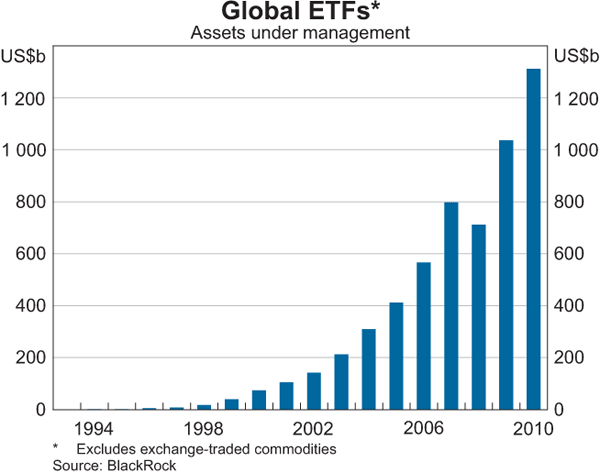
The ETF Industry
ETFs are securities backed by a pool of assets, the return on which is expected to track a specific benchmark as closely as possible. Generally, an ETF will physically hold the underlying assets. For example, an ETF may hold the stocks underlying a benchmark equity index. However, some use derivatives such as futures, forwards, options and swaps to simulate the return from physically holding the asset, and are referred to collectively as synthetic ETFs. ETFs may also use some combination of the two strategies. The differences between physical and synthetic ETFs are discussed in greater detail in the next section.
ETFs are similar to managed funds in that both can provide broad exposure to an underlying asset. However, there are a number of key differences between the two investment vehicles. While investors can trade ETF shares intraday on a stock exchange, transactions in managed funds occur, at most, once a day. ETFs also tend to have lower management fees and brokerage costs because an ETF will not generally buy or sell its underlying assets to create shares (see Box A for details on how ETF shares are created and redeemed in the primary market). Furthermore, ETFs have tax advantages in some jurisdictions, including the United States, because a managed fund may have to sell its holdings to meet redemptions (potentially creating a taxable capital gain), while an ETF does not. Unlike investment in managed funds, ETF investors cannot buy or sell shares directly from the issuer, but instead must make transactions via a stock exchange.
There are around 2,700 ETFs globally, with strong growth in total assets under management over the past decade (Table 1). Those domiciled in the United States account for around US$1 trillion, or 70 per cent, of global ETF assets, with trading in US ETFs equivalent to around one-quarter of aggregate turnover in US equities. In Europe, ETFs have attracted investment of approximately US$300 billion, while those domiciled in Australia have assets of around US$4 billion.
| ETF type | Number of ETFs | Assets under management US$b |
Per cent of total assets |
|---|---|---|---|
| Equity | 1,895 | 1,067 | 74.0 |
| Fixed income | 365 | 217 | 15.0 |
| Commodity(a) | 358 | 147 | 10.2 |
| Other | 86 | 12 | 0.8 |
| Total | 2,704 | 1,442 | 100.0 |
|
(a) Includes exchange-traded commodities. Sources: Bloomberg; RBA |
|||
The majority of ETFs track equity indices. Globally, equity ETFs have around US$1.1 trillion in assets under management and account for around three-quarters of total ETF investment. Equity ETFs allow investors to buy a single security that aims to replicate the return of an entire portfolio of stocks such as the S&P 500 index.
Most equity ETFs focus their investment in equities from a specific country or region (Graph 2). Of these, the number and size of ETFs that invest in emerging market equities have grown strongly, with assets under management of nearly US$200 billion in 2010 from less than US$1 billion in 2001. In some cases, emerging market ETFs are the only way that foreign investors can access these markets. Growth has also been strong in a range of equity ETFs that allow investors to invest in specific equity market sectors, such as financial or technology indices, and style-specific investments, such as ‘growth’ or ‘small-cap’ stocks.
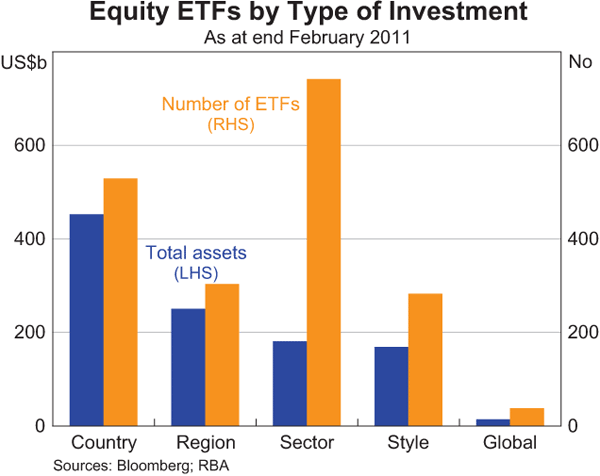
ETFs that track fixed income returns represent 15 per cent of total ETF assets under management. Fixed income ETFs provide investors with access to a range of bond and money market investments, including government and corporate debt, as well as broad aggregates, such as investment-grade bonds and high-yielding securities. The greatest proportion of investment is concentrated in government bonds, comprising around 30 per cent of fixed income ETF assets.
ETFs that track commodities represent 10 per cent of total ETF assets under management and have become one of the most popular means of gaining exposure to commodity prices.[1] Commodity ETFs represent a more cost-effective means of accessing this asset class than alternative investment vehicles. Investment in commodity ETFs has grown from around US$40 billion in 2008 to around US$150 billion in 2010 and now accounts for 40 per cent of total commodities investment (Graph 3).[2] Like futures, holding commodity ETFs does not require the investment in infrastructure needed to buy and store the physical commodity. Moreover, ETFs require a small minimum outlay and are more liquid than other forms of commodities investment. For example, one crude oil futures contract represents an interest in 1,000 barrels of oil and requires an initial investment (margin) of around US$7,000. In contrast, the price of one share in the synthetic United States Oil Fund ETF is currently around US$40.
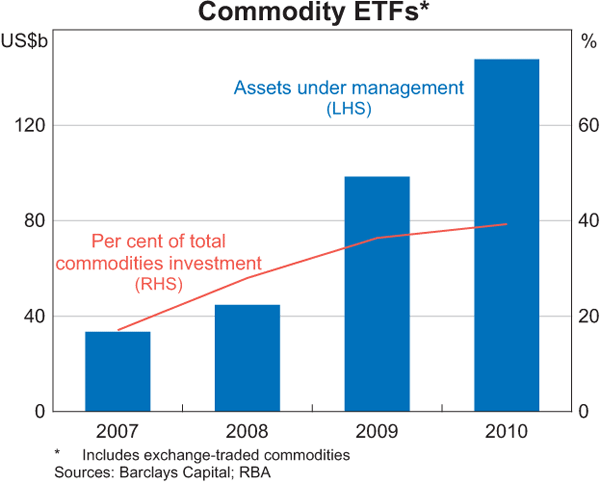
Setting up exchange-traded instruments for commodities is slightly more complicated than is the case for equities. Regulation and the illiquid nature of many commodity markets mean that in some cases commodities cannot be structured in the same legal form as traditional ETFs. This is because investment companies have a restricted range of assets in which they can invest and must also meet minimum requirements for diversification. Therefore, most products in Europe are legally set up as exchange-traded commodities (ETCs).[3] ETCs are technically debt instruments linked to the value of an underlying portfolio of assets (i.e. secured, undated, zero coupon notes). Despite having different regulatory and disclosure requirements, both commodity ETFs and ETCs are similar in the way they trade and both need to be taken into account in forming a complete picture of the size of the commodity exchange-traded product market.
ETFs that are designed to expand investors' allocation opportunities by providing exposure to alternative asset classes and investment structures are becoming increasingly common. Notable examples include ETFs attempting to deliver hedge fund performance and those that track currency returns. There is also a growing number of ETFs, particularly in the United States, which use leverage (predominantly through derivatives) in an effort to enhance returns. These include leveraged ETFs providing specified multiples – often two or three times – of the daily return of an underlying asset. Others, known as inverse ETFs, aim for the opposite (or in the case of leveraged inverse ETFs, multiples of the opposite, such as negative two or three times) return and are used to gain from falling prices or to hedge existing portfolio positions. A small number of ETFs are also available where the fund actively manages its investments, with some attempting to make higher returns than would be earned by passively tracking the return on an asset.
Physical versus Synthetic ETFs
As mentioned previously, there are two common strategies employed by ETFs to achieve the target return: physical and synthetic. Physical ETFs hold the assets underlying a particular benchmark. For example, an equity-based ETF can hold all or a sample of the stocks underlying a benchmark equity index. The advantages of a physical replication strategy include greater transparency of the ETF's asset holdings and more certainty of entitlement for investors should the ETF be liquidated. Restrictions on the use of derivatives in some regions, particularly in the United States, have also contributed to the continued dominance of physical replication. Most ETFs in the United States and Asia Pacific region use physical replication to track their underlying benchmark (Graph 4).
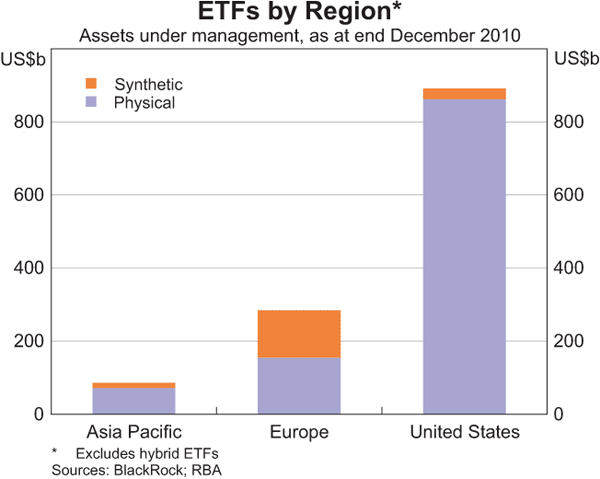
In Europe, however, regulatory changes have seen the use of synthetic ETFs grow rapidly, with such funds accounting for almost half of total ETF assets under management. The advantages of a synthetic strategy can include lower cost, improved accessibility to particular asset classes and investments (including emerging market shares) and greater accuracy in delivering the targeted return. That is, a synthetic strategy can reduce tracking error as the ETF is contractually guaranteed to receive the same return as the underlying asset. For example, physical equity ETFs must rebalance their constituent holdings each time the target index is reweighted, while for a synthetic ETF using swaps, this becomes the responsibility of the swap counterparty. A synthetic strategy may also be necessary when physical replication is not possible (e.g. an ETF may be unable to directly access Chinese shares). However, the structure of synthetic ETFs can be complex and may lack transparency, with the use of derivatives also exposing the ETF to counterparty risk. Box A discusses synthetic ETFs in more detail.
Around four-fifths of investment in commodity ETFs occurs through physical replication (e.g. buying and storing gold bars to track the spot price of gold). Compared with equity ETFs, where synthetic strategies tend to provide lower tracking error, only by holding physical commodities can these ETFs closely track the return on the spot price of the underlying commodity (less fees).[4] Investment in physically backed commodity ETFs is concentrated in precious metals, which are ideal for this structure because they have low storage costs relative to their value, are not perishable and have futures price curves which are frequently in contango (i.e. the futures price for the closest-to-maturity contract is lower than for the next month). Gold accounts for around 80 per cent of investment in physically backed ETFs. The large increase in investment in gold ETFs during the financial crisis has been attributed to gold's safe-haven status (Graph 5). The popularity of these products has seen the number of physical commodity ETFs rise, and the first products backed by holdings of base metals such as copper were launched late last year.
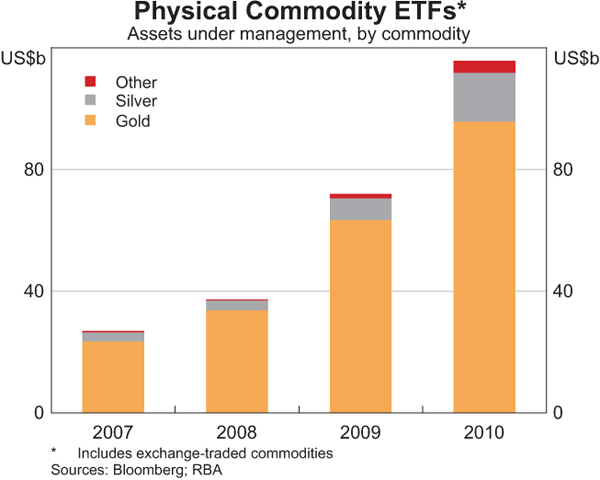
Apart from precious metals, and to a lesser extent base metals, commodities are generally both costly and difficult to buy and store. This has led a number of commodity ETFs to use synthetic replication to achieve their return objectives. A typical strategy involves the ETF purchasing closest-to-maturity futures contracts and rolling them prior to expiry. If the price of the futures contract for the next month is lower than that for the current month – that is, the market is in backwardation rather than contango – then the roll return is positive. As a result, investing in a synthetic commodity ETF can generate a return above the return from holding the physical commodity. The opposite occurs when the market is in contango. In this situation the roll return is negative and the return from investing in such a synthetic commodity ETF will be lower than the return from holding the physical commodity. Because of this, most investment in synthetic commodity ETFs is in energy commodities and broad commodity indices (with large weights given to energy), since the futures curves of these commodities have historically spent most of the time in backwardation (Graph 6).
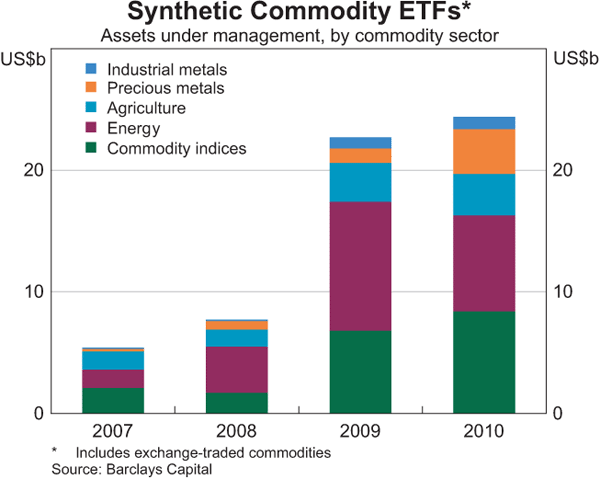
Benefits and Risks of ETF Investment
ETFs can offer a number of benefits to investors, including: a simple, low cost means of diversification and the ability to be bought and sold intraday. As ETFs trade like ordinary shares they can often be short sold (where a security is borrowed and then sold, allowing the seller to profit from falling prices) and investors can use risk-management strategies such as limit and stop-loss orders in making trades. They also enable investors to invest in a range of asset classes, including emerging market equities and commodities that might otherwise be difficult to access. Further, ETFs tend to be a cost-effective method of investing, with expenses generally lower than similar products offered by managed funds.
However, ETF investment does not come without risks and ETFs are increasingly attracting the attention of regulators. Generally, concerns about ETFs stem from liquidity and counterparty risk and, in some cases, complexity and a lack of transparency. An ETF's liquidity on the primary market is linked to the liquidity of the underlying assets. In addition, some ETFs may not trade actively intraday and market volatility can inhibit liquidity for ETFs if large ETF traders withdraw from the market or there is difficulty in creating new ETF shares. Events such as the ‘flash crash’ of the S&P 500 on 6 May 2010, where ETFs were severely affected by the sudden fall in US equity prices, have also raised questions as to their potential contribution to heightened market volatility as well as their broader impact on market structure.
Counterparty credit risk is an issue for synthetic ETFs, particularly those using swaps (see Box A), and those lending the securities underlying the ETF to generate additional income. Collateral arrangements and swap resetting are typically used to address this and attempts have been made by a number of swap-based ETF providers to increase the frequency of swap resetting, with some providers also engaging multiple swap counterparties.[5] There has also been a shift by some ETF providers towards a swap structure where collateral is pledged to the fund. However, this may not guarantee immediate access to the collateral in the event of a counterparty default and highlights the importance of sound collateral management practices.
Finally, there is the issue of complexity and transparency. Part of the appeal of physical ETFs is their simplicity, and some investors are attracted by the fact that their interest in the fund is backed by the assets underlying the benchmark. However, there has been significant growth in the number of ETFs with complicated structures using derivatives to create leverage, as well as funds based on opaque performance benchmarks. In some cases, the exact structure and types of derivatives being used by ETFs are unclear. These more complex investments can vary considerably in both their structures and the risks they present.
Box A: How Do ETFs Work?
The Creation and Redemption Process
ETFs are typically structured as open-ended companies, which allows the number of shares in the fund to vary over time. Unlike managed funds, however, retail and institutional investors must purchase ETF shares on a stock exchange and cannot buy or sell shares directly from the fund. Before an ETF can commence trading, the fund undertakes a process of creation in the primary market (Figure A1). An ETF will create shares in large blocks (typically of between 25,000 and 200,000 shares), referred to as ‘creation units’, which can only be purchased by Authorised Participants – usually market-makers or institutional investors that must be registered with the ETF. To purchase a creation unit in an ETF tracking an equity index, an Authorised Participant does not generally use cash but instead transfers a portfolio of securities to the ETF (usually comprising the shares underlying the index it is tracking).
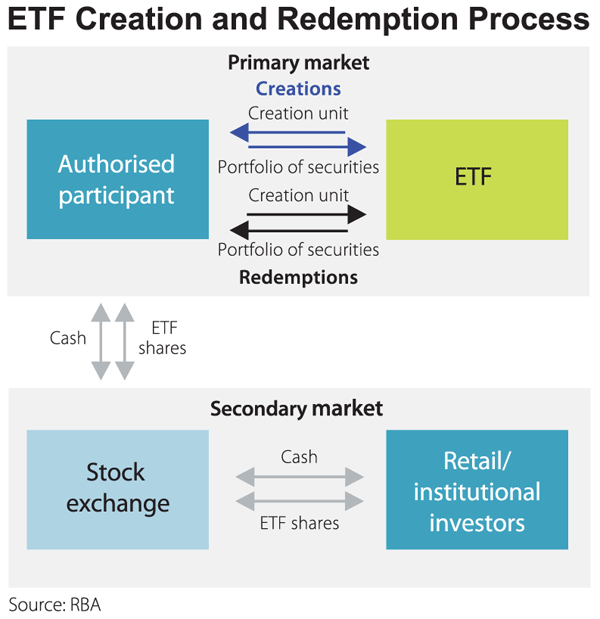
Once the creation unit is transferred to the Authorised Participant, it can be broken up and sold on the secondary market. Only at this point can retail and institutional investors buy and sell ETF shares via a stock exchange. Authorised Participants can also dispose of their shares by selling them back to the ETF through a process of redemption, which is essentially the reverse of creation. Cash may be used during the creation and redemption process for those funds using derivatives to track their benchmark.
Creations and redemptions of ETF shares occur on an on-going basis and are priced at the net asset value (NAV) of the assets held by the fund. ETFs are required to publish daily information about the fund's holdings of securities and NAV, as well as the composition of the portfolio needed for creations and redemptions. On the secondary market, ETF prices are determined through intraday trading on the stock exchange, but should usually mirror the ETF's intraday NAV. Because ETFs trade on the stock exchange, their prices are subject to fluctuations in supply and demand, which may cause the ETF to trade at a premium or discount relative to its NAV. However, these deviations are usually small, with any sufficiently large opportunities exploited by arbitrageurs. Dividends are either paid to investors periodically or reinvested into the ETF.
The Structure of a Synthetic ETF
ETFs may use any number of derivatives, including forwards, futures, options and total return swaps to deliver synthetic exposure to a target benchmark. Swap-based structures are commonly used by synthetic equity ETFs to achieve exposure to the underlying index (Figure A2). Total return swaps are an agreement between two parties to exchange one type of return for another. This involves the fund engaging a swap counterparty, which will be paid a stream of cashflows. In return, the swap counterparty will transfer the complete performance of the target benchmark (e.g. the return on the German DAX index) to the ETF, including both capital gains and dividends. While variations exist, in practice, this can be done in three stages.
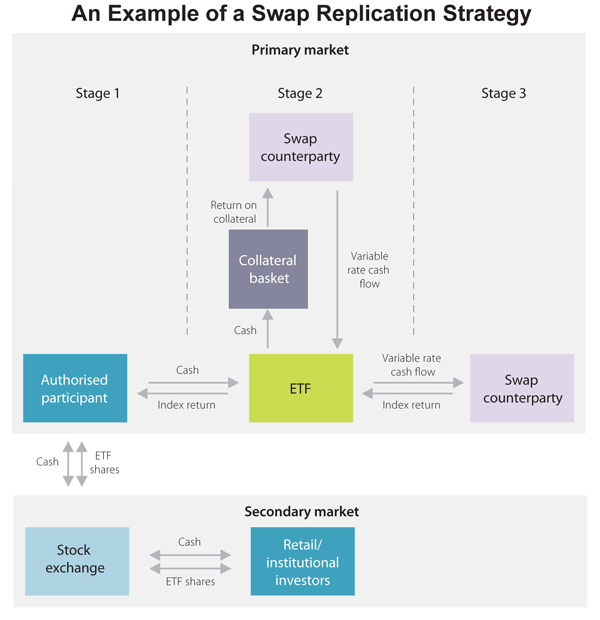
To create shares, an Authorised Participant uses cash rather than a portfolio of assets to buy a creation unit (Stage 1). The ETF then invests the cash in a basket of securities which may not be the same as the asset being tracked by the ETF. The securities held are typically liquid, high quality assets and form the ETF's collateral. The return on this collateral basket is then swapped for a stream of cash flows based on a variable rate such as LIBOR (Stage 2), which the ETF uses to invest in a second swap paying the return on the target asset (Stage 3). Often the counterparty to both transactions is the ETF's parent financial institution (typically an investment bank or asset management firm). While some swap-based ETFs lack transparency regarding the ETF's exact structure, holdings and potential losses in the event of counterparty default, disclosure of this information is improving. For these ETFs, counterparty exposure is managed by the fund regularly resetting (typically daily) the value of the swap.
Another type of swap structure has also evolved in response to investor demands for greater transparency. This involves the ETF investing directly in a swap, rather than a basket of securities, to return the target asset performance. To provide collateral to the ETF, the swap counterparty will enter an agreement to pledge assets to the ETF. Some ETFs have begun publishing information about the composition of the collateral held in the fund's name. The pledged securities are held in a ring-fenced structure with a custodian and are not available for securities lending. The collateral is only accessible by the ETF in the event of a credit default by the counterparty.
Footnotes
The authors are from International Department. [*]
This figure includes exchange-traded commodities. [1]
Total commodities investment includes assets under management in commodity exchange-traded products, commodity index funds and commodity-linked medium-term notes. [2]
There are also products tracking a range of asset classes known as exchange-traded notes (ETNs). ETNs are typically unsecured debt instruments issued and held on the balance sheet of large financial institutions (typically investment banks or asset management firms). In contrast, the assets of ETCs (which are also debt instruments) are often held by a ring-fenced special purpose vehicle to protect against default risk. [3]
The return on commodity ETFs that use synthetic replication can differ substantially from the return on the spot price of the underlying commodity for reasons discussed in more detail below. [4]
Swap resetting occurs when a payment is made by either the counterparty or ETF to match the value of the ETF's holdings to changes in the value of the asset being tracked. [5]